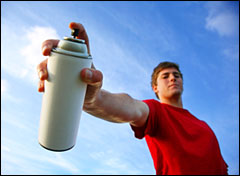Dear Umbra,
Love the column. Keep up the great stuff! A question: My co-workers and I are suspicious of buying spray cans, even though we know they no longer contain CFCs. We suspect that aerosol cans contain HCFCs — hydrochlorofluorocarbons — which are proving to be dangerous as well, this time as greenhouse gases. Do all aerosol cans contain HCFCs? Can we trust a “green” product like an essential-oils-and-water-based deodorizer that comes in an aerosol can? And what about non-aerosol cans — are their contents safe?
Kate
Boulder, Colo.
Dearest Kate,
Thank you for the compliments. In grateful return, I will tell you all I’ve learned about the aerosol can. An aerosol is a wee particle or liquid droplet that’s suspended in air, including natural forms seen in smoke, dust storms, or sea spray from the briny deep. Naturally occurring aerosols are of great interest to climate scientists, as (of course) are the propellants that shoot products out of aerosol cans. In former days, the go-to propellants were CFCs, or chlorofluorocarbons.

Put the can down and back away.
A can creates aerosols much the same way we might transform drool into a fine spray, if we weren’t so gosh-darned busy. If we simply open our mouths and let saliva fall out, we get a goopy liquid (thus, the bib industry). If, on the other hand, we apply pressure and narrow our lips, we can push the liquid out of a smaller hole, and it becomes an aerosol. Aerosol cans follow a similar principle, if a bit more explosively. A liquid product is poured into a can, the can is closed, and gas propellant is pumped in under high pressure. The gas, crowded and uncomfortable, presses hard on top of the liquid. When we press the nozzle, a tiny seal opens inside the bottle and the gas pushes the product out of a too-small hole, rendering it misty or foamy. Then we shave.
The propellants known as CFCs, widely embraced for being non-toxic and non-flammable, were hugely popular until the 1970s, when scientists realized that they broke down in the upper atmosphere and released chlorine. Chlorine, they found, is a “catalytic agent” in ozone destruction, allowing too much ultraviolet light to hit us. An international agreement to phase out CFCs was forged in 1987 and, as of this December, the U.S. ban on ozone-depleting CFCs will be complete.
Unfortunately, manufacturers have used CFC replacements that have problems of their own. HCFCs were substituted for CFCs in many instances, but, though less harmful, they also contain ozone-depleting chlorine. In this country, HCFCs are being phased out and will be completely banned by 2030. I should mention here that there are eye-glazing varieties of all these chemicals, which are used in many assorted ways (not just in aerosol cans) and were banned in different years. For example, according to the U.S. EPA (where no one, apparently, is regulating acronym use) the compound HCFC-141b has the highest ODP, or “ozone depleting potential” — the quantification of badness — of any HCFC, and the U.S. can no longer produce or import it. The EPA offers lists of “acceptable substitutes” that have little or no ODP, which presumably will allow the aerosol industry to continue its fine spraying into the future.
The ozone hole has very little to do with global warming but, as Kate mentions, some of the newer propellants are potent greenhouse gases that have high “global warming potential.” These gases, including hydrofluorocarbons, are far more heat-trapping than CO2, though less abundant. (As you know, greenhouse gases are not regulated in the U.S.) Additionally, the volatile organic compounds found in many propellants are now targets for fussy state governments concerned about clean air.
Unfortunately, I could find no perfect list of which propellant is used by which aerosol can vendor. But I think it’s safe to say that, although aerosol cans make a satisfying noise and well-fluffed shaving cream, it’s usually best if we don’t use them.
Even non-aerosol sprays, which spit lightly upon us via a pump and nozzle, may contain volatile or non-earth-friendly substances. Still, I don’t believe that any volatilizing ingredient in a simple spritz-y deodorizer bottle could compete with aerosol propellants on the environmental-destruction front. Famous last words? I hope not.
Propellantly,
Umbra


